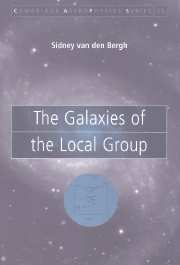Book contents
- Frontmatter
- Contents
- Preface
- 1 Introduction
- 2 Local Group membership
- 3 The Andromeda galaxy (M31)
- 4 The Milky Way system
- 5 The Triangulum galaxy (M33)
- 6 The Large Magellanic Cloud
- 7 The Small Magellanic Cloud
- 8 The elliptical galaxy M32 (= NGC 221)
- 9 The irregular dwarf galaxy NGC 6822
- 10 The starburst galaxy IC 10
- 11 Faint dwarf irregular galaxies
- 12 Spheroidal galaxies
- 13 The most luminous dwarf spheroidal galaxies
- 14 Dwarf spheroidals in the Andromeda subgroup
- 15 Faint dwarf spheroidals
- 16 The outer fringes of the Local Group
- 17 Intergalactic matter in the Local Group
- 18 Dynamical and physical evolution
- 19 Properties of the Local Group
- 20 Conclusions
- Glossary
- Bibliography
- Object Index
3 - The Andromeda galaxy (M31)
Published online by Cambridge University Press: 22 August 2009
- Frontmatter
- Contents
- Preface
- 1 Introduction
- 2 Local Group membership
- 3 The Andromeda galaxy (M31)
- 4 The Milky Way system
- 5 The Triangulum galaxy (M33)
- 6 The Large Magellanic Cloud
- 7 The Small Magellanic Cloud
- 8 The elliptical galaxy M32 (= NGC 221)
- 9 The irregular dwarf galaxy NGC 6822
- 10 The starburst galaxy IC 10
- 11 Faint dwarf irregular galaxies
- 12 Spheroidal galaxies
- 13 The most luminous dwarf spheroidal galaxies
- 14 Dwarf spheroidals in the Andromeda subgroup
- 15 Faint dwarf spheroidals
- 16 The outer fringes of the Local Group
- 17 Intergalactic matter in the Local Group
- 18 Dynamical and physical evolution
- 19 Properties of the Local Group
- 20 Conclusions
- Glossary
- Bibliography
- Object Index
Summary
Introduction
The great spiral in Andromeda is the most luminous member of the Local Group. The first known record of this object is by al-Sufi (903–986). M31 was first viewed through a telescope by Marius, who described it as looking “like a candle seen through a horn,” in 1612. The spiral nature of the Andromeda galaxy was first clearly shown in photographs obtained by Roberts (1887) with a 0.5-m reflector. Ritchey (1917) referred to these arms as “great streams of nebulous stars.” It is listed as object number 31 in Messier's catalog of nebulae. An atlas of finding charts for clusters, associations, variables, etc. in M31 has been published by Hodge (1981). Van den Bergh (1991b) has written a long review paper on this object. The monograph The Andromeda Galaxy by Hodge (1992) provides a detailed historical discussion of research on this object and an annotated bibliography for the period 1885–1950. A monograph entitled Tumannost Andromedy (The Andromeda Nebula) has been published by Sharov (1982).On the sky M31 covers an area of 92′ × 197′ (Holmberg 1958). This large angular size makes the Andromeda galaxy particularly suitable for detailed studies of its structure and stellar population content. De Vaucouleurs (1959b) has shown that the distribution of surface brightness I in spiral galaxies can often be decomposed into a spheroidal component in which I ∼ exp(–R1/4) and an exponential disk in which I ∼ exp(–αR), where R is radial distance and α is a constant.
- Type
- Chapter
- Information
- The Galaxies of the Local Group , pp. 9 - 45Publisher: Cambridge University PressPrint publication year: 2000

